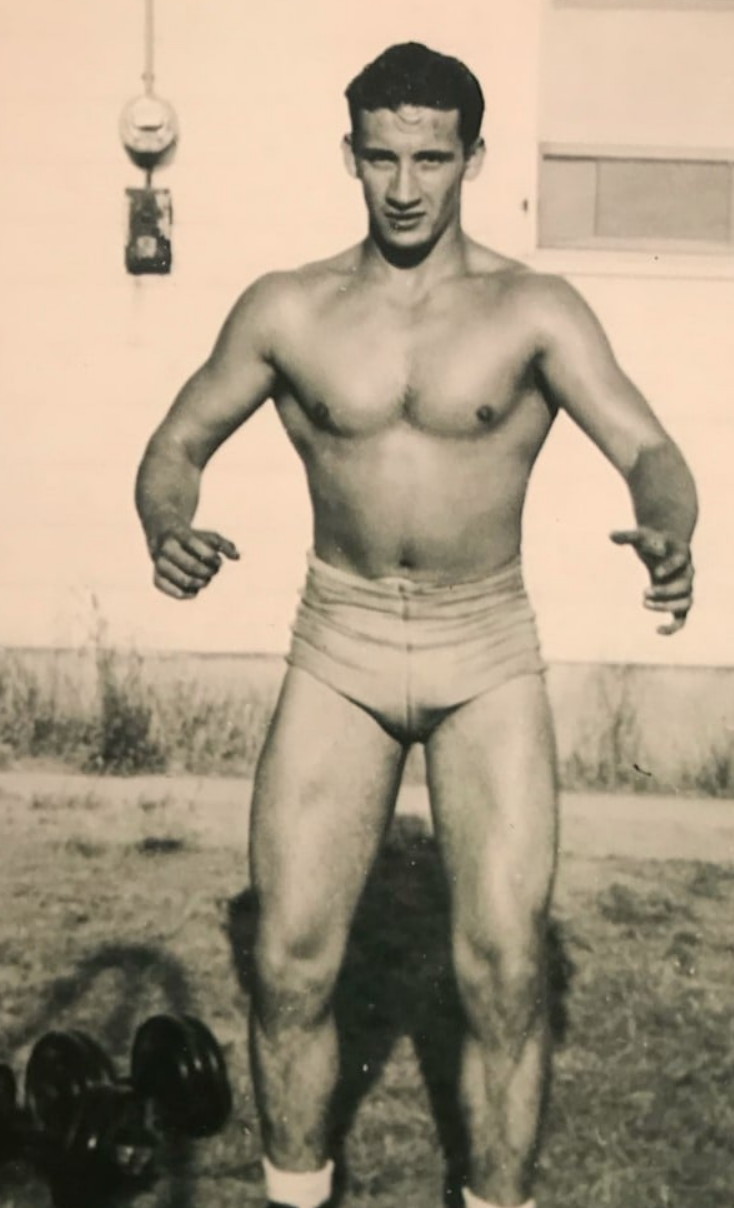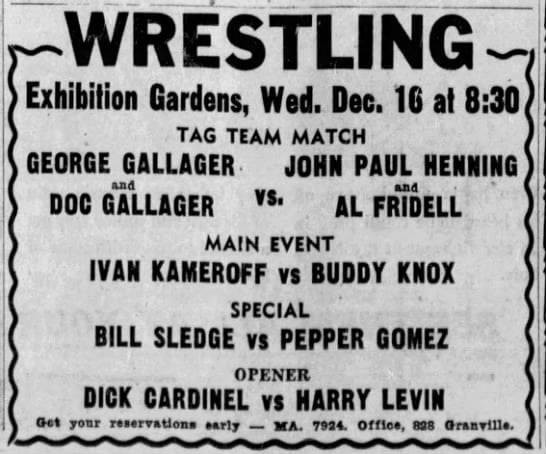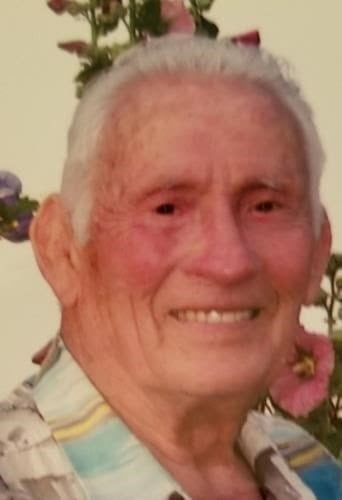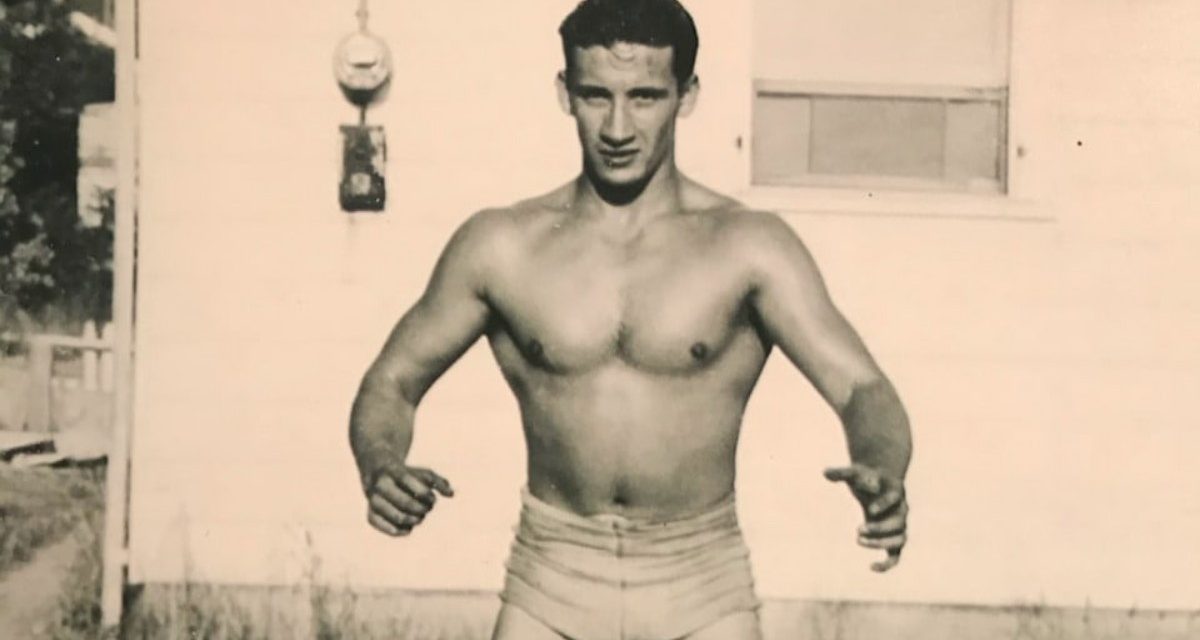By MARK HEWITT – For SlamWrestling.net
“Never a wrestler that couldn’t be rode, never a
wrestler that couldn’t be throwed.”
-Dick Cardinal
Christmas Eve 2020 saw the passing of two legendary wrestlers — Danny Hodge and Dick Cardinal. Aged 88 and 93 respectively, both were known for their legitimate grappling skills.
Hodge, of course, achieved worldwide recognition for his amateur, Olympic, and professional laurels and is hailed as one of the greatest wrestlers of all time.
Cardinal was not quite as well-known, largely because he seldom ventured out of the Pacific Northwest, but he was equally recognized by insiders as being as fine a mat technician as his contemporaries Hodge, Lou Thesz, Karl Gotch and Judo Gene LeBell.
Cardinal died December 24, 2020, in Marysville, Washington. He was preceded in death by his wife and son, and is survived by two daughters and a host of grandchildren, great grandchildren and great, great grandchildren.
Following his pro wrestling career, Cardinal spent 37 years as a coach and teacher in the North Lakewood School District of Washington state. The high school football stadium is named in his honor.
Cardinal was born in 1927 in Everett, Wash., and started wrestling at 11 years of age in the Bremerton YMCA.
“We were drilled hard on takedowns, breakdowns, rides, pins, switches (reversals) and escapes and I loved it. I was the youngest on the team but filled a slot at 108 pounds. I was mauled by my older teammates, but did a little better in meets,” Cardinal recalled.

After winning the Pacific Northwest Amateur Championship tournament, including an upset victory over five-time National AAU champion Glen Northrup, Cardinal was approached by old-time wrestler August “Augie” Sepp and invited to train at his gym. Sepp was always on the lookout for talent and saw real potential in the youngster. Cardinal remembered that the old-timer had “knots for ears.”
Sepp was from Estonia and had traveled around Europe as a wrestler, circus strongman and stilt walker. He barnstormed across the American west as a side bet wrestler. Sepp finally set his roots down in Seattle where he operated a gym in the basement of the Paramount Theater. Sepp continued to wrestle locally, and promoted cards. A very tough bunch of “old school” catch-as-catch-can wrestlers were associated with Sepp, namely Bud Anderson, Vic Short, Art Score and Ben Sherman. These are the men that become young Cardinal’s work-out partners. They had marathon training sessions where they would take turns wrestling one another for hours.
“I always tried to contest wrestlers that were as good or better than myself, primarily because it’s the only way you can improve,” said Cardinal.
Sepp regularly took his troupe of mat men out on the athletic show circuit. Athletic shows, or “AT shows” as they were called, were traveling troupes of wrestlers and boxers that appeared at carnivals, fairs, circuses and rodeos, taking on all comers from the crowd. A cash prize was offered to anyone who could defeat the show wrestler, or even last a certain amount of time without being pinned or forced to concede, AT shows were once a major attraction in the old-time carnival midways and circus “after shows.”
Sepp liked to keep a lighter-weight guy who could handle himself as part of his show, so as not to scare off or intimidate potential challengers, and Cardinal fit the bill. Sepp took a personal interest in training him.
Cardinal spent a decade wrestling with the AT shows in the Northwest, mid-1940s to 1955. Asked to describe a typical program, Dick related:
August would have three of four wrestlers and a boxer up on the bally. 1 We’d be up there strutting, or we might do something like lift the boxer, the lighter guys overhead and that’d attract the people off the midway…we’d play the drum, which was a hot water tank…later we had a siren. We’d get those people gathered around down there and August would throw his challenge out to the crowd. He’d talk us wrestlers up, how tough we were, how good we were. He’d try and get someone to come out of the crowd to wrestle us. Many times we had a plant, 2maybe two plants in the crowd… I was the lightest guy on the platform and I always got the first match so I could protect the guys that couldn’t wrestle. I was doing the ‘policeman’ work for the show…
I had hundreds of ‘shoots’ 3 with ‘town toughs’, loggers, mill workers, cowboys… they were relatively easy to handle…brawlers were handled similarly. We would take them down, usually a leg dive and ride him. After two, three minutes they blow up and you can do what you want with them. When a guy is on the mat it’s difficult for an opponent to get punching leverage. I preferred to be behind, on top, where’s it’s difficult for an opponent to bite, kick, or punch you. We’d ‘hook’ 4 them and request a loud, audible surrender… I wrestled some very good amateur and intercollegiate wrestlers, but they weren’t tough because they went by amateur rules… We’d ‘hook’ them… they didn’t know how to protect themselves from front face locks, double wrist locks and toeholds… They drew well but we never made them ‘smart.’
Cardinal said that a lot of Native Americans would challenge to wrestle and recalled how tough it was to beat them. No matter how much punishment they absorbed they wouldn’t give up. Cardinal recalled one match with Scarborough, a Lummi chief. “You’d ‘hook’ him and he wouldn’t quit… he would rather suffer a broken arm or die than lose face.” Cardinal had him locked up tight with a double arm bar, but Scarborough refused to concede. Once he finally passed out, Cardinal rolled him over and pinned him. Over the years Cardinal faced the Indian chief three times in AT show bouts. He had to pin him each time because he just wouldn’t submit.
Cardinal also wrestled on the pro circuit around the Northwest and up into British Columbia, Canada. He traveled with the AT shows during the fair and rodeo season with Sepp. Cardinal also toured with athletic show operators Bill “Cueball” Loth, Johnnie Buff, Jack “Pappy” Ryan, and Al Lombardi.

A show from Vancouver, BC, on Dec. 16, 1953 with Dick Cardinel (sic).
“In many respects I enjoyed AT shows more than house matches. 5 In the AT show I was not at the whim of any promoter, except Augie who treated me well. There were many ‘works’ but every time we opened the bally, the potential for a contest existed and Sepp dodged nobody,” he recalled. Cardinal said it was not unusual for him to wrestle four or five matches a night during a week-long carnival run.
One of Cardinal’s most memorable bouts was a legitimate contest in 1953 with another skilled wrestler named Glen Detton. In fact, it was a historical matchup, being a rare public “shoot” between two seasoned, professional catch-as-catch-can wrestlers. Detton was the brother of former heavyweight champion Dean Detton and had three other wrestling siblings, Reed, Dory and Joe.
Detton and Cardinal were battling it out for the exclusive right to operate the AT show at the big annual fair in Puyallup, Wash. Sepp had won the bid to set up his show at this lucrative two-week long venue, much to the chagrin of Detton, who had secured the spot for the past few seasons and didn’t want to lose it. Detton threatened to appear in the fair crowd and challenge and beat every one of Sepp’s “boys.” Sepp didn’t take the threat lightly and arranged for their adversary to “shoot” with his top man, Dick Cardinal. If Detton won, they’d relinquish the show spot.
They agreed on a referee, a mutually respected pro wrestler named Clair Robinson (aka Cal Roberts). As word went out about the match, fans and any nearby pro wrestlers that could get there packed the tent.
“I was never out of shape, but I did concentrate harder before the match on my conditioning. I also asked around to try and find out all I could about Detton,” recalled Cardinal. “I found out that Detton was a good sprawler and was an excellent wrist-locker. This helped me develop my strategy for the match. I knew I couldn’t leg dive him, or I’d leave myself open to a wrist lock… so I went into the match cautiously.”
The wrestlers locked up and methodically sparred for holds, careful not to give their opponent any openings. “I was well prepared and very aggressive…it was a controlled aggression…I kept the heat on,” Cardinal said. Cardinal took him down and went after a toehold. He related, “I had him with a good toehold, but I couldn’t lock the damn thing up… Detton crawled off the mat nearly sobbing…We were both tired at this point but I was mean tired and mad because he had crawled off.
“This had been a rather heated contended point at the rules meeting. Sepp insisted the down wrestler would be returned to the under position ring center if the wrestlers went out of the ring. As Sepp said the under wrestler could crawl out, which works to the disadvantage of the aggressive wrestler who has expended great energy to gain the top position. Detton’s representative said that Glen would never crawl out.”
Restarting in the center, Cardinal controlled Detton, wearing him down with a top body scissors. He grabbed another toehold with one hand and secured a head and arm grip with the other. Detton had enough and signaled his submission. Cardinal commented, “He quit probably from exhaustion more than pain.” The match had lasted a total of 12 minutes.
Detton was true to his word and left the Sepp show alone. There were no hard feelings and Cardinal and Detton later formed a popular tag team in the 1960s.
Cardinal hung up his ring gear in 1975, but made a brief comeback under a mask in 1982 as the Nightmare Cowboy to help out a friend’s promotion in Montana.
With his passing, a link to the old-time authentic catch-as-catch-can wrestling and those who plied the trade in the athletic shows and on the pro wrestling circuit is lost. As Cardinal proudly stated, “I’m glad I worked in the AT shows. I experienced a fascinating period of Americana.”

A recent shot of Dick Cardinal.
A dedicated family man, educator, youth sports coach and community leader, Cardinal always relished his time spent on the mat and the knowledge of the game that had been passed down to him. Cardinal was always willing to share what he knew and to “talk wrestling” with anyone interested.
I appreciate having known this fine man and cherish dozens of hand-written letters Dick sent me over the years, relating his mat experiences and insights into catch wrestling. He truly was the last of his breed.
ACKNOWLEDGMENTS
Quotations and commentary are largely based on the author’s research and personal communication and correspondence with Dick Cardinal. Some details come from Army Maguire, Scott Teal, Jake Shannon, Matt Granahan, and Jon Strickland.
FOOTNOTES
1 – The bally was the elevated stage set up outside the tent on which the “at show” men would stand and issue challenges to the crowd. When a contest was arranged, tickets would be sold, and the show would commence inside the tent.
2 – The plants among the spectators were called “sticks” or “outside men.” They were either one of the showmen dressed up like a fairgoer, or a local that they were friendly with. Sometimes a popular local pro or semi-pro wrestler would “work” as the “outside man.”
3 –A “shoot” was a legitimate contest as opposed to a “work” or a bout with an arranged ending. The old-time “at shows” featured both “shoots” and “works”, whatever could “turn the tip”, or motivate the crowd to purchase tickets. A “shoot” with a local pride always generated good business. Cardinal stated, “I think there may have been collectively more ‘shoots’ in the ‘at shows’ than anywhere in the biz.”
4 –Dick Cardinal described a “hook” as “a potentially dangerous bone breaking, joint breaking, severe muscle/ligament stretch which forced an opponent to quit or suffer one or more of the above. Examples would include but not limited to a twisting hammerlock, double wristlock, twisting knee lock, front face lock, step over toe hold, etc.”
5 –A “house show” means a wrestling card held in an indoor venue-arena, stadium, theater, etc.

